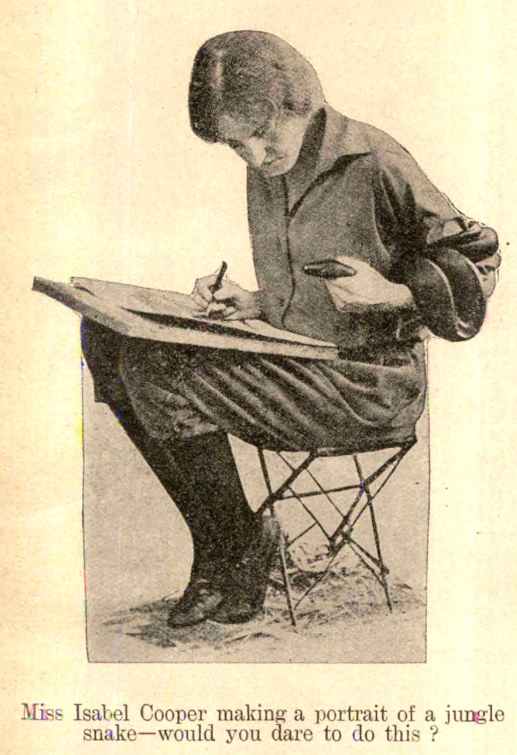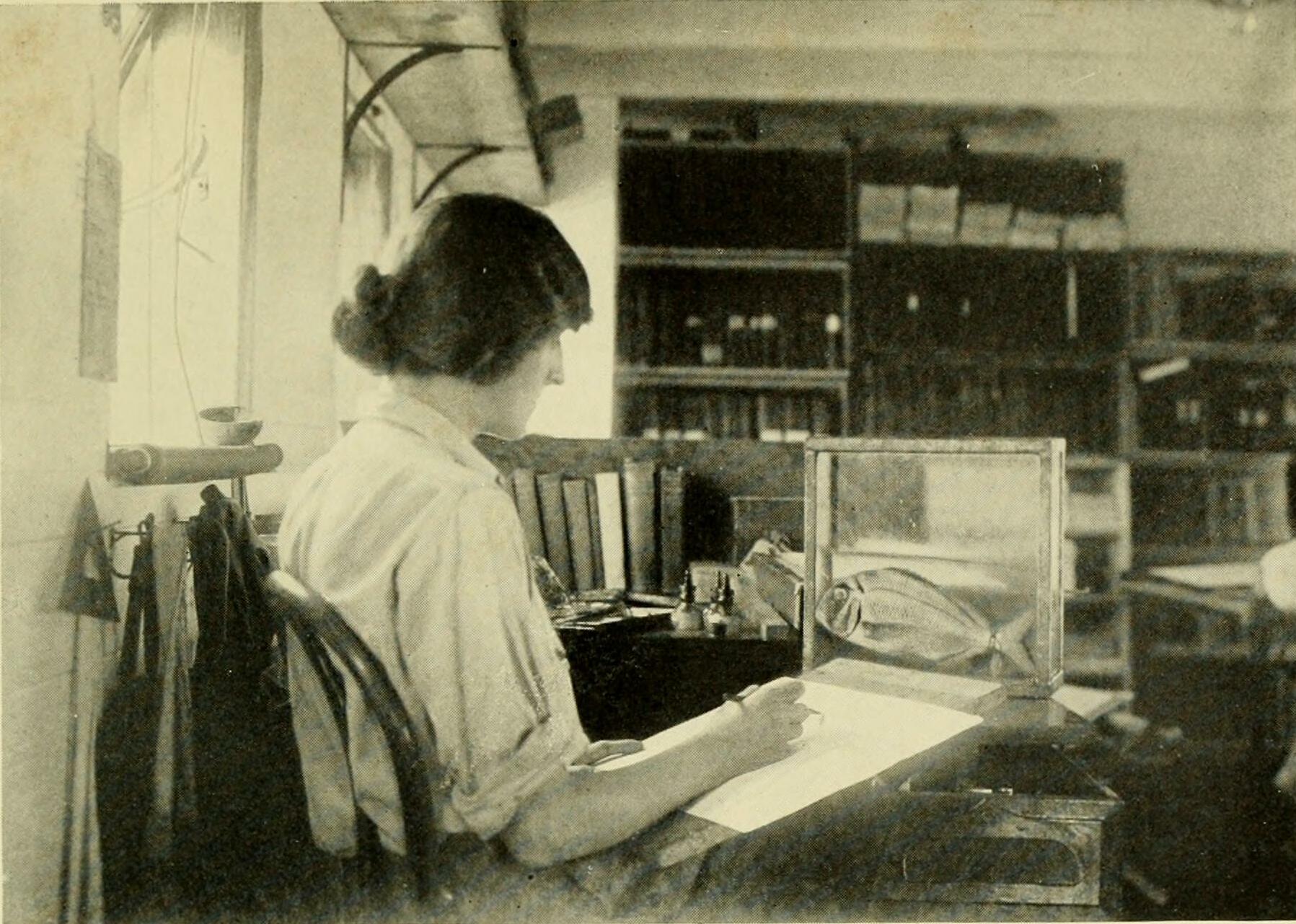Isabel Cooper Mahaffie on:
[Wikipedia]
[Google]
[Amazon]
Isabel Cooper Mahaffie (August 22, 1892 – 1984) was an American artist known for her work depicting animals. She was a staff artist for the New York Zoological Association who participated in multiple research expeditions.
 Cooper was known for her paintings of animals collected during research expeditions. She painted animals that were still alive in order to best capture their colors and character. Some of the animals were anesthetized first with ether so that they remained still while she painted them. Her first pieces were done with watercolors, and then she changed to using Japanese paper colors and India inks.
She made multiple trips while working for the New York Zoological Society including five trips to
Cooper was known for her paintings of animals collected during research expeditions. She painted animals that were still alive in order to best capture their colors and character. Some of the animals were anesthetized first with ether so that they remained still while she painted them. Her first pieces were done with watercolors, and then she changed to using Japanese paper colors and India inks.
She made multiple trips while working for the New York Zoological Society including five trips to  Cooper ultimately provided the illustrations for Beebe's book ''The Arcturus Adventure,'' and ''
Cooper ultimately provided the illustrations for Beebe's book ''The Arcturus Adventure,'' and ''
Biography
Cooper was born on August 22, 1892, inTacoma, Washington
Tacoma ( ) is the county seat of Pierce County, Washington, United States. A port city, it is situated along Washington's Puget Sound, southwest of Seattle, northeast of the state capital, Olympia, Washington, Olympia, and northwest of Mount ...
. She went to Bryn Mawr College
Bryn Mawr College ( ; Welsh: ) is a women's liberal arts college in Bryn Mawr, Pennsylvania. Founded as a Quaker institution in 1885, Bryn Mawr is one of the Seven Sister colleges, a group of elite, historically women's colleges in the United St ...
from 1909 until 1910 and there she played multiple sports, including hockey, basketball, and water polo. Cooper then studied art at Barnard College
Barnard College of Columbia University is a private women's liberal arts college in the borough of Manhattan in New York City. It was founded in 1889 by a group of women led by young student activist Annie Nathan Meyer, who petitioned Columbia ...
and Columbia University
Columbia University (also known as Columbia, and officially as Columbia University in the City of New York) is a private research university in New York City. Established in 1754 as King's College on the grounds of Trinity Church in Manhatt ...
from 1910 to 1912. From 1912 until 1915 she studied at the Arts Student League
The Art Students League of New York is an art school at 215 West 57th Street in Manhattan, New York City, New York. The League has historically been known for its broad appeal to both amateurs and professional artists.
Although artists may stud ...
, an art school in New York City that was founded in 1875, and then had private classes with Alon Bement
Alon Bement (1876–1954) was an American artist, arts administrator, author, and teacher. He served as the Dean of Traphagen School of Fashion from 1946 until 1951.
Early life and education
Alon Bement was born on August 15, 1876, in Ashfield ...
from 1913 until 1917. After graduating from Columbia she worked in multiple jobs including teaching art and science in New York City schools, interior decorating, theater set designing, and rug making. She met William Beebe, the head of the Department of Tropical Research at the New York Zoological Society, and he hired her to work as a staff artist recording the animals found on scientific expeditions, a job she held from 1917 until 1925.
Cooper was married to lawyer Charles Delahunt Mahaffie on August 25, 1928, and they had a son, Charles D. Mahaffie Jr.
She died in Bethesda, Maryland in 1984.
Work as an artist
 Cooper was known for her paintings of animals collected during research expeditions. She painted animals that were still alive in order to best capture their colors and character. Some of the animals were anesthetized first with ether so that they remained still while she painted them. Her first pieces were done with watercolors, and then she changed to using Japanese paper colors and India inks.
She made multiple trips while working for the New York Zoological Society including five trips to
Cooper was known for her paintings of animals collected during research expeditions. She painted animals that were still alive in order to best capture their colors and character. Some of the animals were anesthetized first with ether so that they remained still while she painted them. Her first pieces were done with watercolors, and then she changed to using Japanese paper colors and India inks.
She made multiple trips while working for the New York Zoological Society including five trips to British Guiana
British Guiana was a British colony, part of the mainland British West Indies, which resides on the northern coast of South America. Since 1966 it has been known as the independent nation of Guyana.
The first European to encounter Guiana was S ...
, two trips to the Galapagos, and one trip to Asphalt Lake in Venezuela. The trips to British Guiana were to the research station at Kartabo Point on the Mazaruni River
The Mazaruni River is a tributary of the Essequibo River in northern Guyana. Its source is in the remote western forests of the Pakaraima Mountains and its confluence with the Cuyuni River is near Bartica. As it descends from the Guiana Highlands ...
. Her return to the research station was documented in 1920, 1922, and 1924. While at the research station Cooper focused on amphibians and reptiles, especially those that had only previously been preserved as specimens in alcohol. In 1924, Helen Damrosch Tee-Van, Ruth Rose
Ruth Rose (January 16, 1896 – June 8, 1978) was a writer who worked on several films in the 1930s and the 1940s, most famously the original 1933 classic ''King Kong''.
Early life
Rose was born on January 16, 1896 to a playwright, Edwa ...
, and Cooper captured a large boa constrictor which caught the attention of the press describing the research expeditions. Her work was shown at a 1921 exhibit at the New York Zoological Society in Bronx Park. Cooper illustrated Beebe's 1924 book ''Galapagos: World's End'' which was reviewed favorably by the media.
Following the 1924 expedition to British Guiana, Cooper wrote an article for ''The Atlantic Monthly
''The Atlantic'' is an American magazine and multi-platform publisher. It features articles in the fields of politics, foreign affairs, business and the economy, culture and the arts, technology, and science.
It was founded in 1857 in Boston, ...
'' about the challenges she faced in painting animals while in the jungle, and the delight she had in her unconventional job. In the article she described the challenges of painting live animals, some of which managed to escape from their cages while she was working. She later described her job as "the most peculiar job in the world".
Cooper participated in Beebe's 1925 ''Arcturus'' expedition that sailed from New York City on February 11, 1925. The expedition went from New York to the Sargasso Sea
The Sargasso Sea () is a region of the Atlantic Ocean bounded by four currents forming an ocean gyre. Unlike all other regions called seas, it has no land boundaries. It is distinguished from other parts of the Atlantic Ocean by its charac ...
to the Galápagos Islands
The Galápagos Islands (Spanish: , , ) are an archipelago of volcanic islands. They are distributed on each side of the equator in the Pacific Ocean, surrounding the centre of the Western Hemisphere, and are part of the Republic of Ecuador ...
, and then returned to New York on July 30, 1925. Even though Cooper got seasick on boats, she generated illustrations during the cruise and used a diving bell to go under the seawater. The ''Arcturus'' expedition was widely shared in the press, and even when they were out of contact news stories about the expedition were published. The news coverage included multiple pictures of Cooper and the other people on board.
Multiple women were part of the research crew including Marie Poland Fish
Marie "Bobbie" Dennis Poland Fish (May 22, 1900 – February 2, 1989) was an American oceanography, oceanographer and Marine biology, marine biologist known for her bioacoustics research and the finding of eel eggs in the Sargasso Sea. Her resear ...
, Ruth Rose
Ruth Rose (January 16, 1896 – June 8, 1978) was a writer who worked on several films in the 1930s and the 1940s, most famously the original 1933 classic ''King Kong''.
Early life
Rose was born on January 16, 1896 to a playwright, Edwa ...
, Helen Damrosch Tee-Van, and Lillian Segal
Lillian Segal Root (formerly Kopeloff), best known as Lillian Segal, was an explorer known for her participation in William Beebe's 1925 ''Arcturus'' expedition where she examined how light was produced by deep sea fish.
Biography
Segal was fro ...
. This was unusual for the time and William Beebe's involvement of the women in research expeditions was highlighted in the news. Before sailing on the Arcturus expedition, Beebe noted that he preferred working with women and that "If it were feasible I would have my entire scientific party made up of them...Fine minds are as necessary in modern research exploration as fine courage. It is easier to find fine women than fine men."
 Cooper ultimately provided the illustrations for Beebe's book ''The Arcturus Adventure,'' and ''
Cooper ultimately provided the illustrations for Beebe's book ''The Arcturus Adventure,'' and ''The New York Times
''The New York Times'' (''the Times'', ''NYT'', or the Gray Lady) is a daily newspaper based in New York City with a worldwide readership reported in 2020 to comprise a declining 840,000 paid print subscribers, and a growing 6 million paid ...
'' reported "Isabel Cooper's colored plates are gorgeous." She also provided illustration for scientific papers on crustacean
Crustaceans (Crustacea, ) form a large, diverse arthropod taxon which includes such animals as decapods, seed shrimp, branchiopods, fish lice, krill, remipedes, isopods, barnacles, copepods, amphipods and mantis shrimp. The crustacean group ...
s, and illustrated ''David goes voyaging'', the children's book about the twelve-year old David Putnam's participation in the ''Arcturus'' expedition.
Cooper's later artistic works include painting a jungle-themed guest room in the Rye, New York home of George Putnam and Dorothy Binney Palmer
Dorothy Binney Putnam Upton Blanding Palmer (July 20, 1888 – May 9, 1982) was an American explorer, socialite, and friend to Amelia Earhart.
Early life
Palmer, born Dorothy Binney on July 20, 1888, was the daughter of Edwin Binney, the manu ...
. In 1926 there was an exhibit of Cooper's watercolors at the Corcoran Gallery of Art
The Corcoran Gallery of Art was an art museum in Washington, D.C., United States, that is now the location of the Corcoran School of the Arts and Design, a part of the George Washington University.
Overview
The Corcoran School of the Arts & Design ...
in Washington,D.C. From 1927 until 1931 she made art plates for Encyclopedia Britannica which included insectivorous plants.
Awards and honors
In 1922 she was named an honorary life member of the New York Zoological Society. Two species of moths have been named after Cooper: '' Cirphis cooperi'' and '' Paectes isabel''.References
External links
* {{DEFAULTSORT:Cooper, Isabel 1892 births 1984 deaths American women artists Female explorers Women naturalists Bryn Mawr College alumni Columbia University alumni Art Students League of New York alumni Animal artists